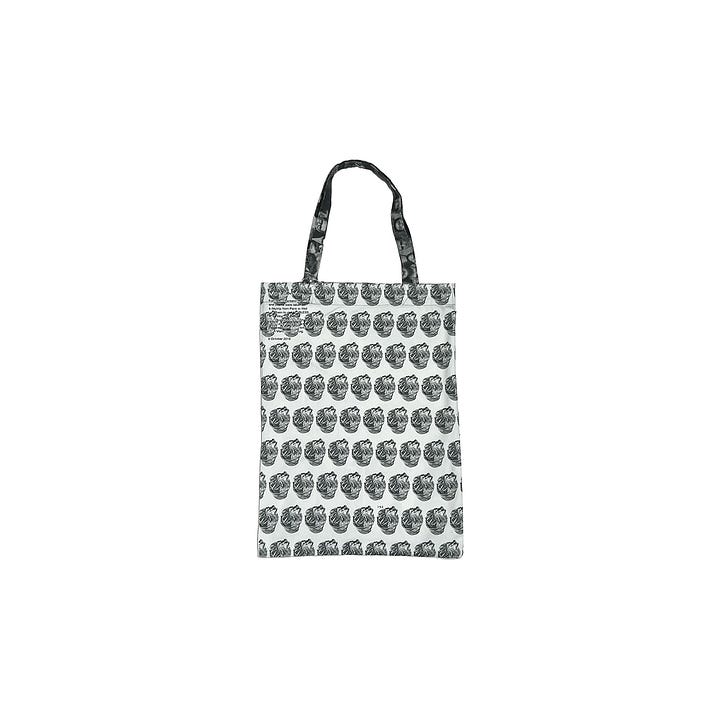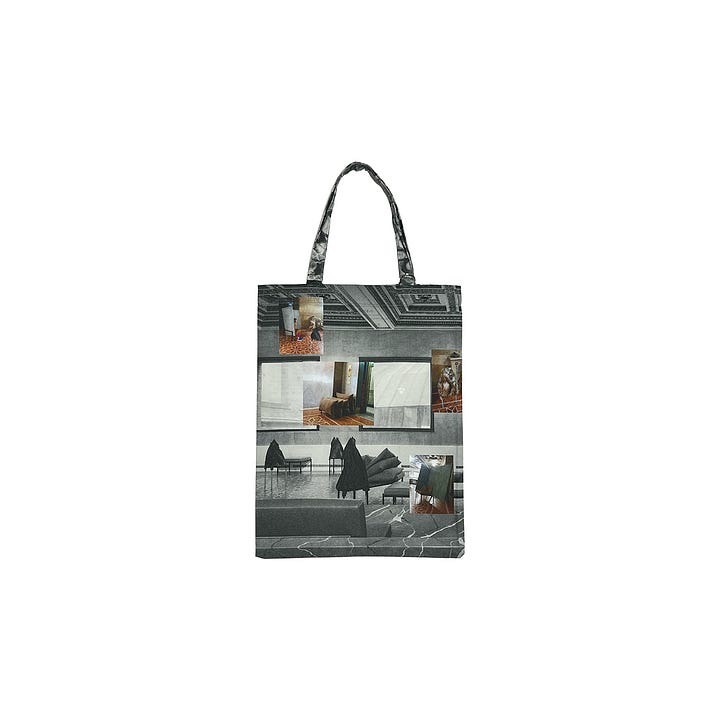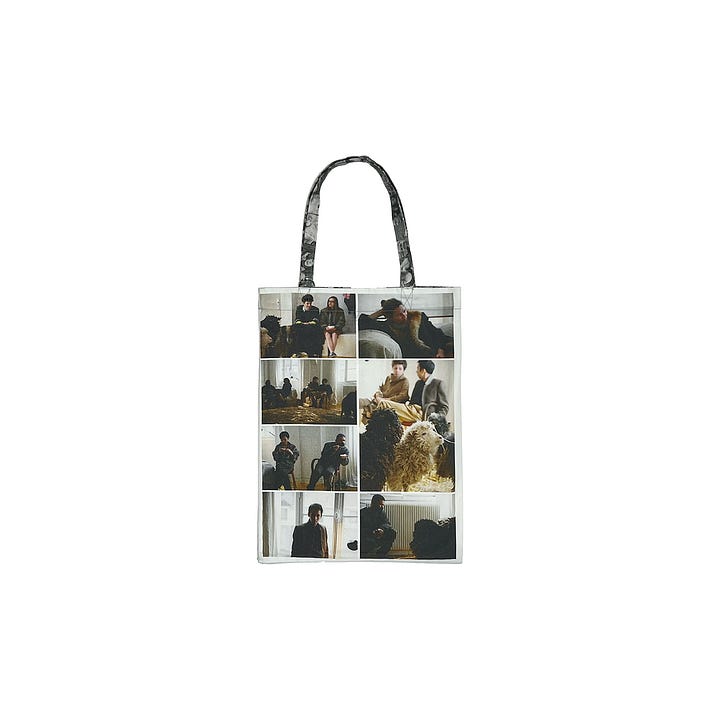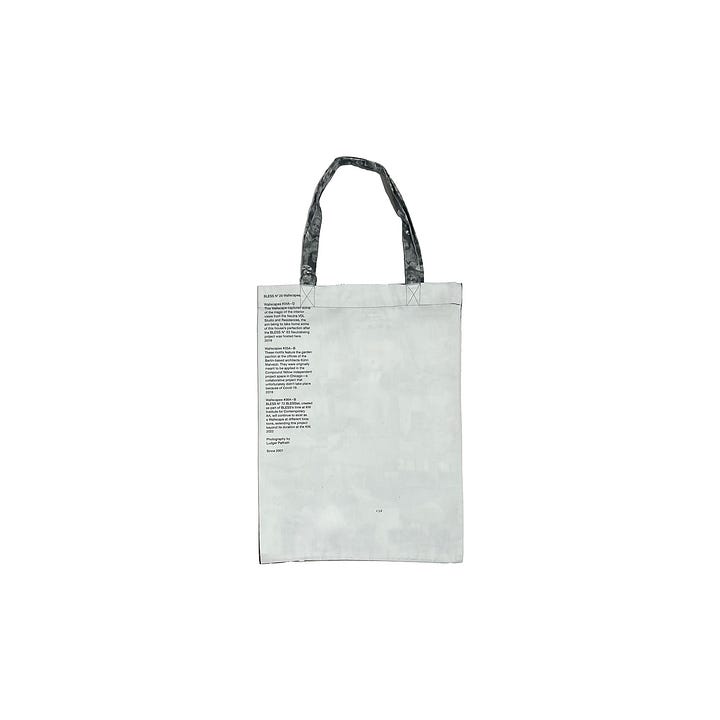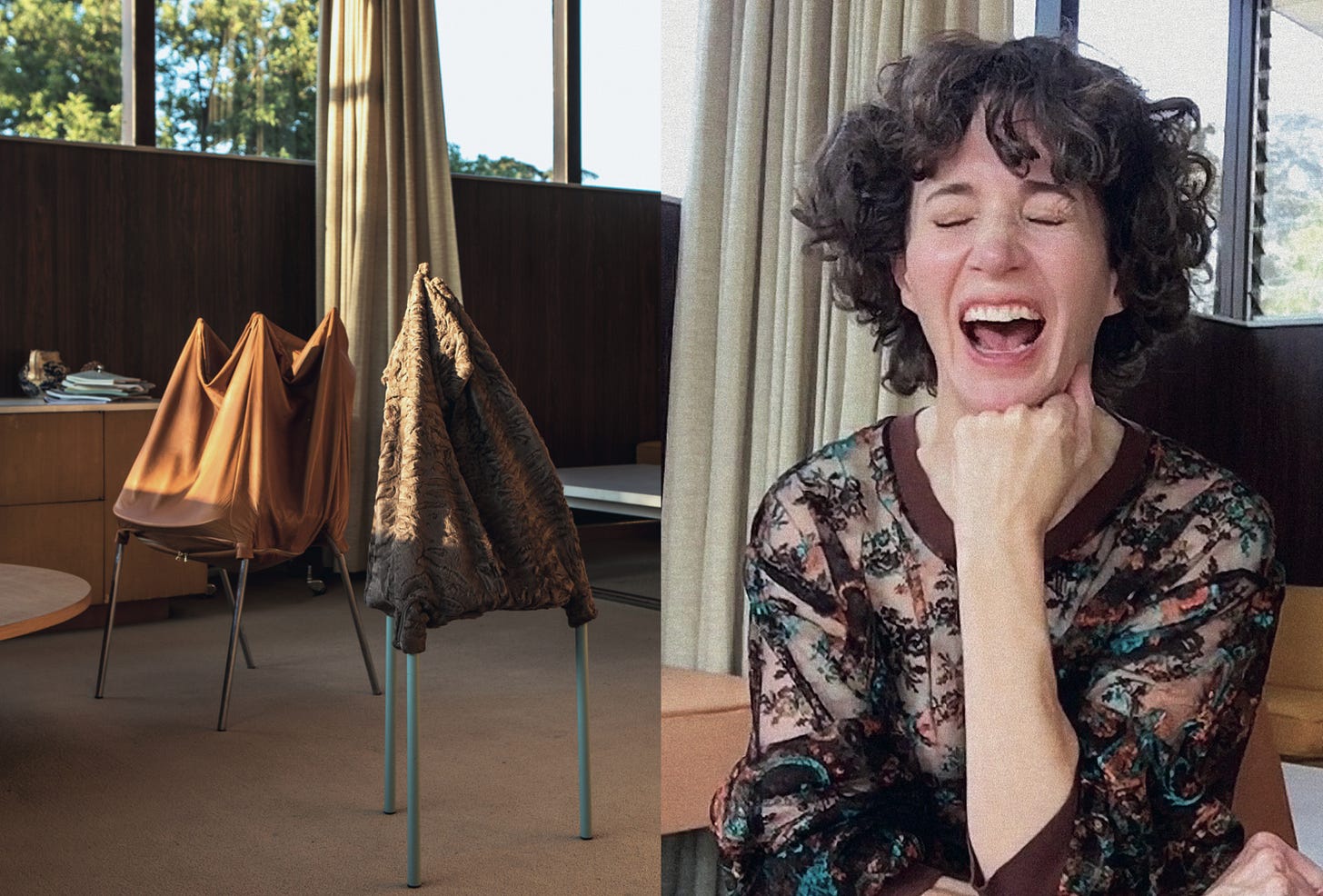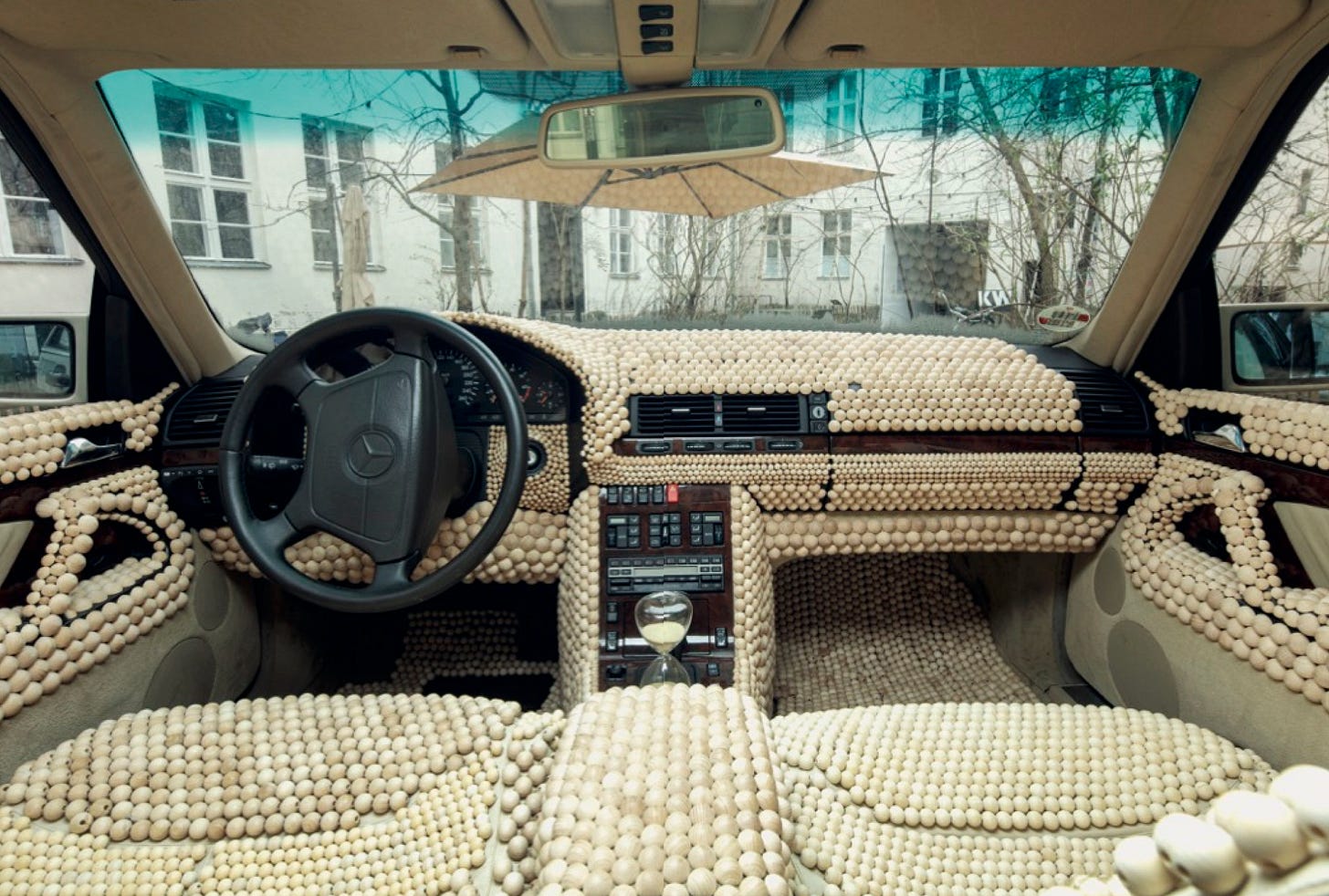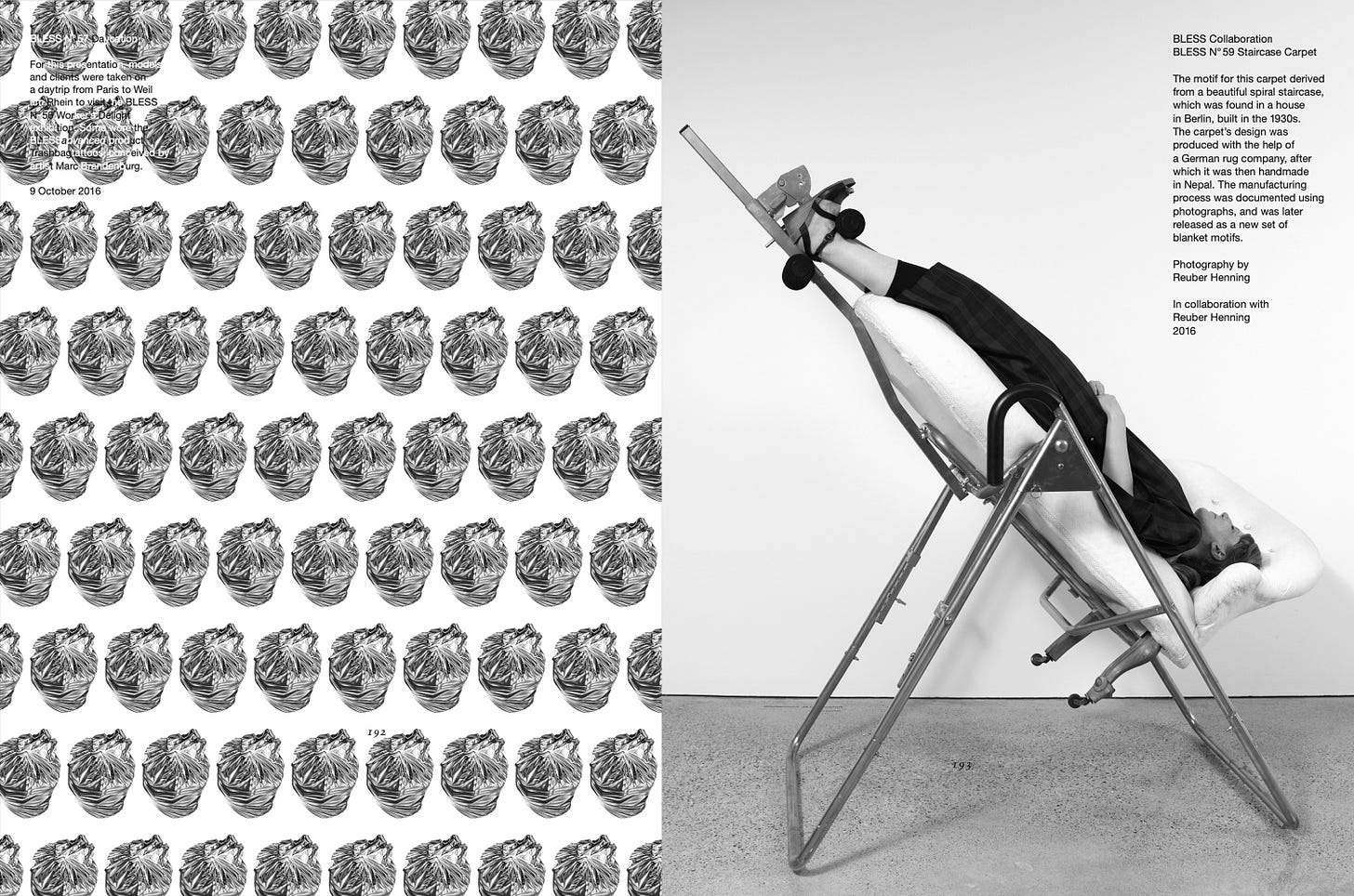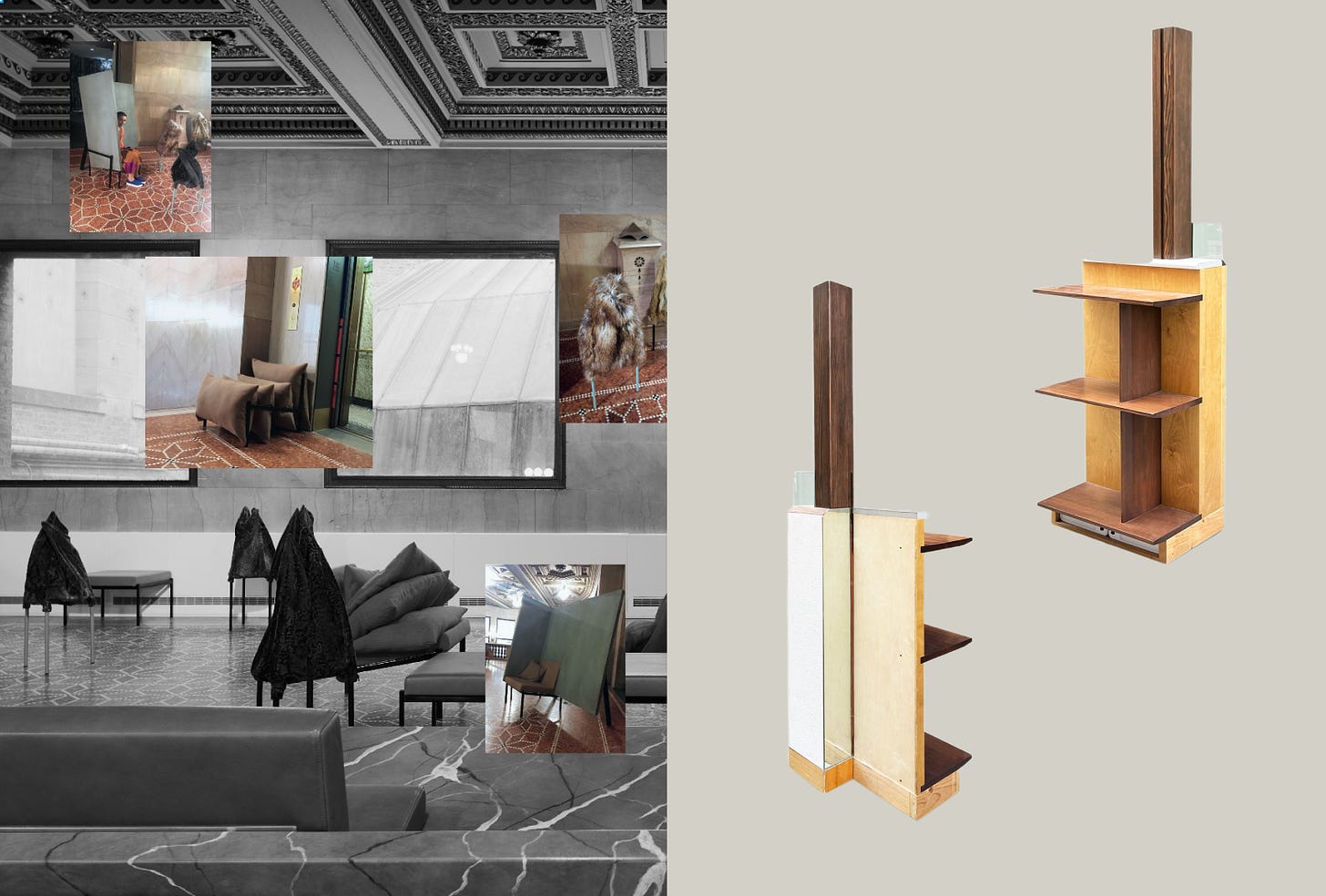BLESS, The Woman Without Anxiety
An exclusive interview with the Paris and Berlin based duo Desiree Heiss and Ines Kaag.
IN CONVERSATION WITH
BLESS, The Woman Without Anxiety
Interview with Desiree Heiss and Ines Kaag by Renata Mosci Sanfourche
BLESS is a woman without any anxiety to conform. Created in ‘95 by the German duo Desiree Heiss and Ines Kaag, she’s off-the-grid, mother of her own discipline, her own profession, her own process, her own language. What BLESS has birthed into our growing material world is a constant desire to confront our patterns of behavior and respond to industry. If you were a
fan in 2018, you may remember their collaboration where the writer appears in a series of videos inside the neighborhood BLESS had moved into. “One Saturday,” July writes in an Instagram post, “I slipped in when they weren’t home and wore their clothes and practiced some loose thinking—which is super easy to do in their world.” Yes, BLESS makes clothes, accessories, and objects, she writes, but most important, she creates concepts, because she’s above all a dynamic environment and independent practice that Heiss and Kaag have chosen to live with.In BLESS N°42 Plädoyer der Jetztzeit (pleading for the present moment), you’ve chosen to use the German term Jetztzeit. This is a unique word established by Walter Benjamin in his last major essay, to convey the idea of “time filled by the presence of the now”. What does using this term mean to BLESS, and to this body of work?
First, we should explain our passion in ‘title designing’ as it is a discipline we developed from the very beginning and established as a structuring element, together with the system of numbering our collections (a BLESS collection comprises a variety of products that came to life in a certain time frame). In general, the titles refer to a specific aspect, act as headlines for some elements, or are messages and statements related to the time being—a comment on a political occasion or simply facts we want to draw attention to. Later, the titles help us remember the moment we found them, as if they were headlines in a bless diary.
In the case of Jetztzeit, we wanted to emphasize our wish of acting in the moment more than developing products for a specific time, or lifespan. Jetztzeit as “time filled by the presence of the now,” feels like a good wish and promise for long lasting companionship. We’re both native German speakers who like to play with the typical German language possibility to construct new words by attaching nouns, this often triggers new creations that we regard as important for a product. Sometimes this could even kickoff an idea we would include in the collection.
What’s your definition of a home or an interior, and what kind of qualities do you try to bring to spaces when you design and conceive objects?
It’s interesting that, while reading your question, we realize it’s the kind of question we never ask ourselves, we never try to find definitions for things. Maybe because we like for them to stay in constant motion. Do we need to verbally define a home or an interior when what we love are the multitude of aspects, definitions, and promises the word home can hold? When it comes to our vision of interior, there is strangely also the urge to open it up, to let the outside in, to bring both together. Interior itself is boring and only one side of the game. Only when experienced, thought, and brought together with the outside it becomes somehow complete, like the yin and yang principle.
In the description of BLESS N°07 Tablecare from Livingroom, it says “the charm of old furniture as experienced companions reacts with environmental accessories on the way to a personal living concept.” What kind of possibilities does the relationship this interaction creates open for its user?
BLESS N°07 Livingroom Conquerors came to life in 1999 during a time when people had discovered the concept store formula, such as Colette. Inside these shops, you could blindly trust and buy anything from their curated selection, you knew it was somehow hype or at the edge of the moment. The only thing these shops couldn’t provide were products with traces of lived moments, so people who thought they could consume and relate to taste blindly, were outed by the relatively antiseptic newness of their surroundings.
In the midst of this contemporary setup, we pledged to think of new furniture less as purchasing entirely new pieces to substitute one’s old furniture, but as dressing the items one’s lived with for quite a while in new gowns that would provide fresh shapes, and give them new aesthetic and functional options.
BLESS rarely designs entirely new things, we often use familiar items as a base to build on and/or evolve into something else. In this way, the new never comes from a cold and harsh approach, it brings trust to build on one’s own life experiences, to welcome the new while embracing the familiar.
What is your approach to antiques?
Like anybody and anything that experienced a certain lifespan, antiques are charged with depth, traces of usage and touch that new products can’t provide. A bit like old wine that becomes more complex with time. This can be a plus, can be quite emotionally charged. At the same time, it can also be a burden and a weight that doesn’t allow one to simply let go to freely and lightheartedly construct from scratch. As with anything else, using antiques requires responsibility and a great sense of balance of how much old and new you need to feel your life all right.
I find BLESS to be extremely playful. Last year, I watched a video at your Paris store from when BLESS N°50 Todaying invited people to an apartment full of sheep. Is play an intentional element in your work, and is there any conscious correlation to play and psychological development?
We guess the example you give here illustrates quite well how much we act unplanned and ‘drive-by-sight’, allowing things to happen and to surprise us. In this particular case, we met a wholesale client and friend, by chance, in a café, two days before our small presentation in an apartment, it was to be quite ordinary, with no special features. Of course she asked us what the new collection was about, and we told her about our boredom, that it’s always the same, and that the only characteristic of this collection was that it used lots of wool. Her nonchalant reply was that we should get sheep.
We went back to the office and asked our collaborator to organize sheep, and she managed. We told our model friends there would be surprise guests. Everyone thought that eventually someone well known would show up. It was also the first presentation where we regretted not collecting the mobile phones prior to the arrival of the sheep, we barely found pictures of this presentation without our models having phones in their hands to take pictures of themselves in this situation.
The wallscapes we see in BLESS N°29 have potential to really transform a space. What is the intention behind making a space appear to be what it’s not? What emerges from this?
The BLESS N°29 Wallscapes were originally developed for our retrospective show at the Boijmans Van Beunigen Museum in Rotterdam in 2006. It was to be a quick fix for the eternal and imminent BLESS question of how to expose products that were made to be applied to daily life, not for exhibition purposes. The wallscapes offered a 2D solution by transporting real-life interiors, where BLESS items could potentially live, into the museum. By mixing them in the museum’s architecture, with pieces from their permanent collection, they formed an equally harmonious and exciting environment that offered visitors new perspectives of the museum and its contents, and new insight of the BLESS world.
To attach a life-size motive to a space means to direct the attention of the viewer. The space naturally opens to another dimension: the products you see in the picture seem to make sense as their appearance and application is proved by the picture. Products that you place in front of the motive, or attach directly to the wallscapes, profit from that aura as well. We like to interfere in spaces and bring not only a specific product, but its whole entourage into a situation.
This is a way to emphasize that an idea, or a design, is not only a disconnected object, but wants to be seen in connection and correlation with its environment. The question of where the physical object starts and ends is an interesting one.
BLESS N°41 Retrospective Home and N°56 Worker’s Delight, really play with the idea that we don’t interact with the world in the same ways we used to, and that at times this can be harmful for our well-being. Why was broaching this topic important for BLESS?
Although BLESS was never a fashion label in a classic sense, we still started from a rather garment and object point of view after both of us had studied fashion. It was only in recent years though that we understood the main quality of our work experience, and achievement with and through BLESS, is that we managed to form our own personal, made-to-measure profession, that offered us the ultimate luxury to work on whatever we would love to work on, disrespecting completely categorization of any kind. We’re aware that we created en passant a very precious path of working through living, and the other way around, which is today what we are the proudest of and take pleasure in.
What kind of relationships have you established with your own homes in terms of your personal lives and everyday needs? How has your interaction with space changed since you created BLESS?
Funny enough not a lot of BLESS products live in our homes. Most likely because we always needed the bigger pieces to generate our income through their sales. However, many products were triggered through personal needs even if we end up living with first-prototype versions of them.
What is the architumiture we see in BLESS N°60 Lobby Conquerors?
BLESS N°60 was a dream collaboration, where our friends Mark Lee and Sharon Johnston from Johnston Marklee architects, curators of that architecture biennial, brought us together with Artek. Again, it was very clear to us that we had nothing to exhibit, but would love to create a nice resting situation in the venue’s generous lounge area. The fur stools resembled home pets more than furniture pieces, while the other chairs contained pieces of architecture. The client who purchased the Corner chair baptized it the ‘anti-social chair’, because of its quality to hide you away and provide privacy. We’re happy this project evolved over the years into BLESS N°63 Architecture Reminiscences and BLESS N°66 Architecture Souvenir Baggages, where we rebuilt cut-out pieces of environments that hosted some of our projects. The pieces are somehow ‘takeaway’ architecture pieces that serve as luggage, and provide you with the possibility to take bits and pieces of these locations to another as mobile souvenirs. There will certainly be more in the future. They’re in a way a 3D complement to the wallscapes, coming simply from a different approach, but providing again an interior piece from somewhere else.
Can you explain the philosophy behind BLESS N° 67 Situation Designer, and how the term situation design came to exist and define BLESS’s professional field?
The term situation design is a temporary one, we won’t exclude that we’ll find still another title for our profession as BLESS evolves. For the moment, we simply feel comfortable to shift away from bringing materialized work into this overcrowded world. It’s more interesting for us to move with all our senses into a situation, to create a memorable moment collectively.
The BLESS N°77 BOOKBAG
All the images featured in this interview are extracts from the book Celebrating 25 Years of Always Stress with BLESS N°42-N°74, which was also produced as a limited edition series of tote bags featuring its contents (see below). One bag corresponds to one page (front and back), and there is one bag available for each of the book’s 200 double-spreads.

